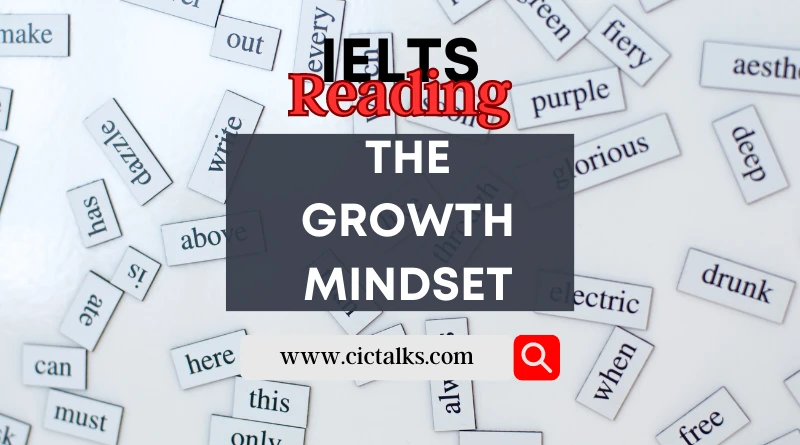The Growth Mindset – IELTS Reading Passage With Answers
Practice The Growth Mindset IELTS Academic Reading with Answers, Explanation, and PDF.
The Growth Mindset
READING PASSAGE
Read The Growth Mindset Reading Passage below. You should spend about 20 minutes on the given questions.
Over the past century, a powerful idea has taken root in the educational landscape. The concept of intelligence as something innate has been supplanted by the idea that intelligence is not fixed, and that, with the right training, we can be the authors of our own cognitive capabilities. Psychologist Alfred Binet, the developer of the first intelligence tests, was one of many 19th-century scientists who held that earlier view and sought to quantify cognitive ability. Then, in the early 20th century, progressive thinkers revolted against the notion that inherent ability is destiny. Instead, educators such as John Dewey argued that every child’s intelligence could be developed, given the right environment.
‘Growth mindset theory‘ is a relatively new – and extremely popular – version of this idea. In many schools today you will see hallways covered in motivational posters and hear speeches on the mindset of great sporting heroes who simply believed their way to the top. A major focus of the growth mindset in schools is coaxing students away from seeing failure as an indication of their ability, and towards seeing it as a chance to improve that ability. As educationalist Jeff Howard noted several decades ago: ‘Smart is not something that you just are, smart is something that you can get.’
The idea of the growth mindset is based on the work of psychologist Carol Dweck in California in the 1990s. In one key experiment, Dweck divided a group of 10- to 12-year-olds into two groups. All were told that they had achieved a high score on a test but the first group were praised for their intelligence in achieving this, while the others were praised for their effort. The second group -those who had been instilled with a ‘growth mindset’ – were subsequently far more likely to put effort into future tasks. Meanwhile, the former took on only those tasks that would not risk their sense of worth. This group had inferred that success or failure is due to innate ability, and this ‘fixed mindset’ had led them to fear of failure and lack of effort. Praising ability actually made the students perform worse, while praising effort emphasised that change was possible.
One of the greatest impediments to successfully implementing a growth mindset, however, is the education system itself: in many parts of the world, the school climate is obsessed with performance in the form of constant testing, analysing and ranking of students – a key characteristic of the fixed mindset. Nor is it unusual for schools to create a certain cognitive dissonance, when they applaud the benefits of a growth mindset but then hand out fixed target grades in lessons based on performance.
Aside from the implementation problem, the original growth mindset research has also received harsh criticism. The statistician Andrew Gelman claims that ‘their research designs have enough degrees of freedom that they could take their data to support just about any theory at all. Professor of Psychology Timothy Bates, who has been trying to replicate Dweck’s work, is finding that the results are repeatedly null. He notes that: ‘People with a growth mindset don’t cope any better with failure… Kids with the growth mindset aren’t getting better grades, either before or after our intervention study.’
Much of this criticism is not lost on Dweck, and she deserves great credit for responding to it and adapting her work accordingly. In fact, she argues that her work has been misunderstood and misapplied in a range of ways. She has also expressed concerns that her theories are being misappropriated in schools by being conflated with the self-esteem movement: ‘For me, the growth mindset is a tool for learning and improvement. It’s not just a vehicle for making children feel good.’
But there is another factor at work here. The failure to translate the growth mindset into the classroom might reflect a misunderstanding of the nature of teaching and learning itself. Growth mindset supporters David Yeager and Gregory Walton claim that interventions should be delivered in a subtle way to maximise their effectiveness. They say that if adolescents perceive a teacher’s intervention as conveying that they are in need of help, this could undo its intended effects.
A lot of what drives students is their innate beliefs and how they perceive themselves. There is a strong correlation between self-perception and achievement, but there is evidence to suggest that the actual effect of achievement on self-perception is stronger than the other way round. To stand up in a classroom and successfully deliver a good speech is a genuine achievement, and that is likely to be more powerfully motivating than vague notions of ‘motivation’ itself.
Recent evidence would suggest that growth mindset interventions are not the elixir of student learning that its proponents claim it to be. The growth mindset appears to be a viable construct in the lab, which, when administered in the classroom via targeted interventions, doesn’t seem to work. It is hard to dispute that having faith in the capacity to change is a good attribute for students. Paradoxically, however, that aspiration is not well served by direct interventions that try to instil it.
Motivational posters and talks are often a waste of time, and might well give students a deluded notion of what success actually means. Teaching concrete skills such as how to write an effective introduction to an essay then praising students’ effort in getting there is probably a far better way of improving confidence than telling them how unique they are, or indeed how capable they are of changing their own brains. Perhaps growth mindset works best as a philosophy and not an intervention.
Questions 14-16
Choose the correct letter, A, B, C, or D.
Write the correct letter in boxes 14-16 on your answer sheet.
14. What can we learn from the first paragraph?
A) where the notion of innate intelligence first began
B) when ideas about the nature of intelligence began to shift
C) how scientists have responded to changing views of intelligence
D) why thinkers turned away from the idea of intelligence being fixed
15. The second paragraph describes how schools encourage students to
A) identify their personal ambitions.
B) help each other to realise their goals.
C) have confidence in their potential to succeed.
D) concentrate on where their particular strengths lie.
16. In the third paragraph, the writer suggests that students with a fixed mindset
A) tend to be less competitive.
B) generally have a low sense of self-esteem.
C) will only work hard if they are given constant encouragement.
D) are afraid to push themselves beyond what they see as their limitations.
Questions 17-22
Look at the following statements (Questions 17-22) and the list of people below.
Match each statement with the correct person or people, A-E.
Write the correct letter, A-E, in boxes 17-22 on your answer sheet.
NB You may use any letter more than once.
- The methodology behind the growth mindset studies was not strict enough.
- The idea of the growth mindset has been incorrectly interpreted.
- Intellectual ability is an unchangeable feature of each individual.
- The growth mindset should be promoted without students being aware of it.
- The growth mindset is not simply about boosting students’ morale.
- Research shows that the growth mindset has no effect on academic achievement.
| List of People |
|---|
| A. Alfred Binet B. Carol Dweck C. Andrew Gelman D. Timothy Bates E. David Yeager and Gregory Walton |
Questions 23-26
Do the following statements agree with the views of the writer in Reading Passage The Growth Mindset?
In boxes 23-26 on your answer sheet, write:
YES – if the statement agrees with the views of the writer
NO – if the statement contradicts the views of the writer
NOT GIVEN – if it is impossible to say what the writer thinks about this
- Dweck has handled criticisms of her work in an admirable way.
- Students’ self-perception is a more effective driver of self-confidence than actual achievement is.
- Recent evidence about growth mindset interventions has attracted unfair coverage in the media.
- Deliberate attempts to encourage students to strive for high achievement may have a negative effect.
The Growth Mindset Reading Answers
| Question | Answer |
|---|---|
| 14 | B |
| 15 | C |
| 16 | D |
| 17 | C |
| 18 | B |
| 19 | A |
| 20 | E |
| 21 | B |
| 22 | D |
| 23 | YES |
| 24 | NO |
| 25 | NOT GIVEN |
| 26 | YES |
The Growth Mindset Answer Explanation & PDF
The Growth Mindset Academic Reading test evaluates a variety of reading abilities, including your capacity to follow an argument and identify a writer’s viewpoint, attitude, or intent. When reading this passage about the growth mindset, it evaluates your ability to comprehend primary ideas, specifics, viewpoints, and implicit meanings.
If you have a doubt and seek an explanation to any answer whatsoever. Feel free to comment below 🙂
Tell us in the comments if you need The Growth Mindset test PDF.
HERE’S ANOTHER READING PASSAGE Alfred Wegener: Science, Exploration and the Theory of Continental Drift THAT YOU MAY TRY!
ALL THE BEST!



